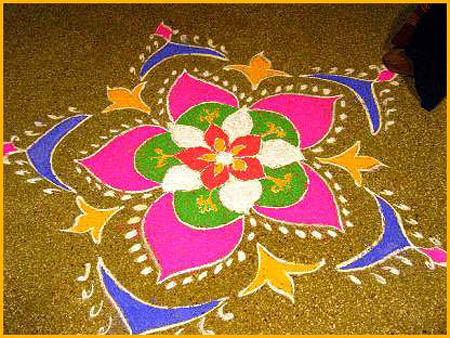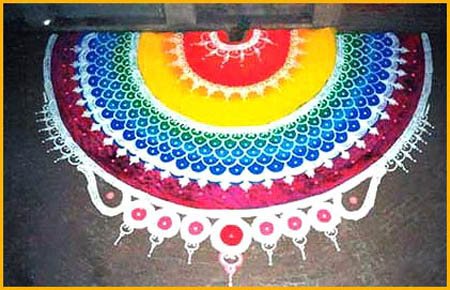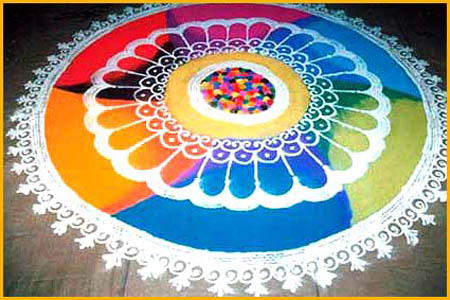
Diwali Celebration
 |



This Is Doorstep Drawings.Amusing Colors and Designs! Doorsteps are inviting to all people for diwali at indian people home. Its an indian tradition for a festival called Diwal.Diwali has many legends and religious accounts to it. Lights and diyas are lit to signifying the driving away of darkness and ignorance, as well as the awakening of the light within ourselves. Diwali is a time for family gatherings, food, celebration and pooja. The goddess Laxmi plays a major role in this festival, as do Ram and Sita. This autumn festival is celebrated for five continuous days, of which each one has its own significance.The house is kept clean and rangoli is drawn at the doorstep to welcome Goddess Laxmi. For the best time for puja, a pandit is consulted. The general things needed for a diwali puja are silver and gold coins, suparis, uncooked Rice, paan leaves, kumkum for applying tilak, mithaai (Indian sweets), camphor, agarbattis (incense sticks), dry fruit (almonds, cashews), flower petals and Lakshmi-Ganesh icon.
Bhai Dooj, also known as Bhai Dooj Tikka Festival is one of the very important Indian festival and is celebrated with lot of joy and enthusiasm. Just as Diwali passes there begins an eager wait for Bhai Dooj celebration. Brothers and sisters shop for traditional Indian Mithais and special gifts for their siblings. Sisters also prepare special Pooja Thali to carry out Bhaidooj ceremony. Brothers bless their sisters and give them cash or Bhai Dooj Gifts.
 Bhai Dooj is usually celebrated a day after the festival of Diwali. So, the Bhai Dooj Date can be calculated as the second day after diwali. On the day of Bhai Dooj Festival, sisters wake up early and prepare delicious festive food for their dear brother. As a custom, usually brothers' make a visit to their sister's place. Sisters' make their brother sit on an asana to carry out the ceremony. A sister then applies tika and akshat on brother's forehead and perform arti of him. She also give puts a sweet in brother's mouth and pamper him with gifts. Carrying out this simple ceremony sisters pray to the divine for the long life, health and happiness of her brother. Reciprocating the loving gesture, brother blesses his sister and indulges her with cash or delightful Bhai Dooj Gifts. Following this the family shares a happy time and relish the Bhai Dooj special food. These days brothers and sisters move out in the evening and recollect happy moments shared in the past.
Bhai Dooj is usually celebrated a day after the festival of Diwali. So, the Bhai Dooj Date can be calculated as the second day after diwali. On the day of Bhai Dooj Festival, sisters wake up early and prepare delicious festive food for their dear brother. As a custom, usually brothers' make a visit to their sister's place. Sisters' make their brother sit on an asana to carry out the ceremony. A sister then applies tika and akshat on brother's forehead and perform arti of him. She also give puts a sweet in brother's mouth and pamper him with gifts. Carrying out this simple ceremony sisters pray to the divine for the long life, health and happiness of her brother. Reciprocating the loving gesture, brother blesses his sister and indulges her with cash or delightful Bhai Dooj Gifts. Following this the family shares a happy time and relish the Bhai Dooj special food. These days brothers and sisters move out in the evening and recollect happy moments shared in the past.
| Introduction India is a melting pot of races and religions. Every religion has its own unique style of celebration. But Diwali (Deepawali), the Festival of Light, is celebrated with fervor and gaiety among all races and religions. The festival symbolizes unity in diversity. The celebration of this five-day festival commences on Aswayuja Bahula Chaturdasi and ends on Kartika Shudda Vijiya. Hindus all over the world celebrate Deepawali with great enthusiasm. This is a major Hindu festival honouring Mother Lakshmi – the goddess of wealth. Diwali is a holy tradition, not to be put in the shade. It symbolizes the victory of light over darkness; darkness refers to ignorance and light refers to knowledge. Celebrated joyously all over India, it is a festival of wealth and prosperity. |  |
Deepavali is celebrated 20 days after Dussehra, on Amavasya - the 15th day of the dark fortnight of the Hindu month of Ashwin (Aasho) in (Oct/ Nov) every year. | |
Diwali or Deepaawali means an Array of Lamps i.e .Rows of diyas (Deep = Lamp, Vali =Array)
Of all the festivals celebrated in India, Diwali is by far the most glamorous and important. Enthusiastically enjoyed by people of every religion, its magical and radiant touch creates an atmosphere of joy and festivity.
As a family festival, it is celebrated 20 days after Dussehra, on the 13th day of the dark fortnight of the month of Ashwin (October / November).
It is a festival of lights symbolizing the victory of righteousness and the lifting of spiritual darkness. It celebrates the victory of good over evil - and the glory of light. This festival commemorates Lord Rama's return to his kingdom Ayodhya after completing his 14-year exile.
 Homes are decorated, sweets are distributed by everyone and thousands of lamps lit to create a world of fantasy.
Homes are decorated, sweets are distributed by everyone and thousands of lamps lit to create a world of fantasy.
Diwali is a time for fun and revelry. Diwali is also a time for pooja and tradition.
